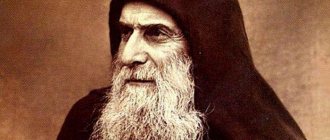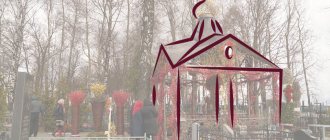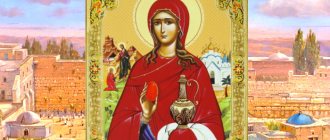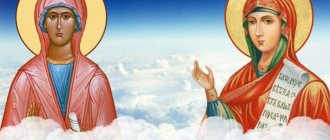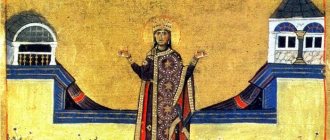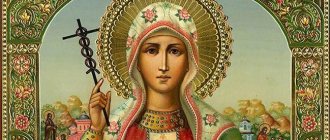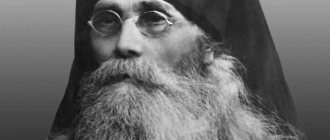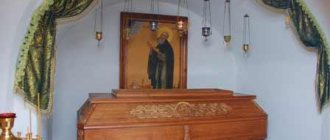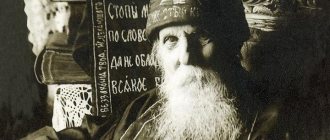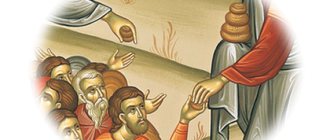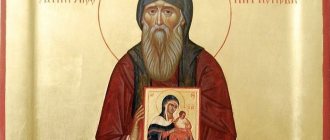Anthony of Dymsky is a monk whose information is so scarce that for a long time the life and personality of Anthony were considered legendary, and information about them unreliable. But for more than seven centuries there has been a monastery founded by him on Lake Dymskoye, the saint’s holiness is attested to by many miracles.
Life of St. Anthony of Dymsky
The monks who compiled the story about the life of the first abbot of the Dymsky Monastery were based on local traditions and legends.
The paucity of information (lack of reliable data on the date, place of birth, childhood years) is explained by two reasons:
- Saint Anthony of Dymsky did not desire human glory, dedicating his life to God. He did not value his earthly virtues, as well as preserving the memory of himself among his descendants.
- Fires, destruction, desolation of the monastery during and after enemy invasions.
At the end of 1156, in a village near Novgorod, a boy named Anthony was born into a God-fearing family. From an early age he was a devotee of prayer in God's temple. Children's pranks and fun were alien to him. Already as a youth, he once heard words from the Holy Scriptures that sank into his soul and determined his future path in life: “If anyone wants to come to Me, let him deny himself and take up his cross and come to Me.”
Young Anthony decided to enter a monastery and devote himself to serving the Lord. He left his family and went to a monastery in the vicinity of Novgorod. The abbot of the Khutyn Transfiguration Monastery, Varlaam, tonsured him monastically and became his spiritual mentor. Anthony was distinguished by his special zeal in fulfilling the monastic rule.
In 1187, with the blessing of the abbot, he went to Constantinople on monastic affairs and to venerate the holy places. His return at the end of 1192 coincided with the death of the Monk Varlaam, by whose desire and blessing Anthony became abbot of the Khutyn monastery. In managing the monastery, the monk preserved the rules of life of the brethren established by Varlaam. His activities and righteous life aroused the love of believers and inhabitants.
The Monk Anthony was burdened by the veneration of pilgrims and the monastic brethren and prayed to the Lord and the Mother of God to indicate a place for a solitary feat. A few years later, he left the monastery and retired to the deep forests near Tikhvin. On the shore of Smoky Lake he built a cell, dug a cave for wintering and began to lead a hermit’s lifestyle.
Courageously enduring the heat, cold, and hunger, Anthony worked during the day and prayed to the Lord at night. To wear down his flesh, the saint wore a heavy iron cap without taking it off. Soon, monks began to come to the hermit, wanting to become ascetics as Anthony. By the general decision of the brethren and with the blessing of Novgorod Archbishop Isaiah, the Dymsky Monastery was founded, of which Anthony became abbot for life.
On June 24, 1224, the reverend father reposed. The day of the meeting of the soul with the Lord was opened to him. On the eve of his death, the saint said goodbye to the monks, blessed them and received the Holy Mysteries. The remains of the saint were buried in the monastery church. After the death of the saint, miraculous healings began to be observed through prayers over his tomb and after placing an iron cap on his head.
After 146 years, the monks opened the burial of Anthony and discovered that his relics had not been touched by decay. The reliquary with holy relics was placed in the chapel of the temple for veneration by believers and monastery brethren. In 1409, fearing the Tatar invasion and mockery of the holy relics, at the behest of the abbot, they were interred. In 1655, the Holy Trinity Cathedral was erected over the burial site. In 1744, a gilded wooden shrine was installed over the saint’s grave. The raki kept an iron cap that weighed 3 kilograms.
The Monk Anthony remained the custodian of the monastery he founded. He appeared twice in a dream to the abbot of the monastery and warned about a fire. In 1611, the Swedes burned the monastery, but it was revived again not without the prayer of the saint.
Hermitage of Saint Anthony
After a while, Anthony decided to live a hermit’s life and retired to the shores of Lake Dymskoye. He worked during the day and prayed at night. He voluntarily wore a wide-brimmed wrought iron hat on his head. The hermit spent a lot of time in spiritual endeavors, almost twenty years.
Stories about the great desert dweller attracted other people with a desire for solitude. New cells appeared on the shores of Lake Dymskoye. Later, the general council of monks decided to create a new monastery in memory of the first founder of the hermitage, Anthony the Great.
Anthony lived in the monastery until his death and became famous for his eternal remains and many miracles; he was buried in the monastery. During the time of Dmitry Donskoy, the relics of the righteous Anthony were placed in the St. Anthony Church.
The saint's feast day is January 17.
Iconography
The iconography of Anthony of Dymsky contains icons, drawings and engravings dating from the 17th-19th centuries and made by Novgorod Orthodox icon painters or Old Believer authors. On iconographic images, the Monk Anthony of Dymsky is depicted full-length or waist-length.
Depending on the period in which the account was written, the saint is represented:
- At the beginning of the 17th century: in the clothes of a schema-monk, with a doll on his head, blessing with his right hand and with a scroll in his left hand, on which you can read: “Behold, I went away, running, and settled in the desert, waiting for God to save me”; "Do not grieve, my brothers."
- The second half of the 17th century, after the appearance of the life of the saint: a schematic outfit, with a doll on the head, praying to the Lord in the heavenly sphere, against the backdrop of a forest thicket, a lake and a monastery surrounded by a high fence.
- Late 17th century: life-size image with the right hand facing the Savior and an unfolded scroll in the left.
On all depictions the saint is represented as an old man with a light brown, wedge-shaped beard.
Holy relics
In order to avoid desecration of shrines during the Tatar raid, the tomb with the relics of Anthony of Dymsky was hidden in the ground, and church items, bells and the saint’s iron cap were hidden at the bottom of the lake. Since then it has been called “Holy”.
The best article for you, go to: St. Theodosius of Totemsky
In 1585, the Swedes began to threaten the borders of Novgorod. Twenty-six years later, the structure was destroyed by Swedish soldiers. The monastery opened only eighty years later. After the October Revolution, the fate of all monasteries awaited him. The building was given to a psychiatric hospital, then it was occupied by the Alumina plant.
The Monastery of Anthony of Dymsky in Tikhvin received a revival only in the nineties of the last century. On the seven hundred and seventy year anniversary of the saint’s death, a stone cross was erected near the lake. It was decided to return the Dymskaya monastery to the Orthodox Church. In 2008, the remains of the righteous were given to the Dymsky Monastery.
Sunday, January 30, 2022
Sunday is a day off, which every Christian devotes to God and His works, first of all, to visiting church. On this day we put aside other things to participate in the liturgy.
In the “Getting Ready for Sunday” project, we are trying to help you consciously come to Church, study the traditions and features of the service in advance, get acquainted with a passage from Holy Scripture and its interpretations, as well as the short lives of the saints commemorated by the Church on Sunday, January 30 .
“Try more than ever to remain in unity with each other, and mainly with the Lord, and then with the saints,” - this is how, at the end of his life, the Monk Anthony the Great instructed the hermits and righteous people who settled near the mountain, where he spent 20 years in complete solitude.
One of the greatest Christian ascetics, the founder of desert living and the Christian monastic tradition in general, lived 105 years - from 251 to 356. According to legend, he was 20 when he heard the gospel call in the temple: “If you want to be perfect, go, sell your property and give it to the poor; and you will have treasure in heaven; and come and follow Me” (Gospel of Matthew, chapter 21). When Anthony's noble and wealthy parents died, the young man refused a large inheritance, distributed the money to the poor and retired to the nearest desert - the Thebaid. In Upper Egypt, he earned his living by his own labor and visited other ascetics (for example, Paul of Thebes) for instruction. The hermit asked the Lord to show him the way of salvation. In response, he received a vision in which a certain hermit alternated prayer with labor. Anthony established such a routine for himself, and spent more than 70 years in fasting, prayer and hard work .
In memory of St. Anthony the Great, everyone who later bore this name was named, including the founder of monasticism in Rus', St. Anthony of Pechersk.
According to some sources, the relics of St. Anthony were discovered and transferred 3 times: to Alexandria in the 6th century, to Constantinople in the 7th century, and in 980 to the city of Arles (France), where they are still kept. However, in the monastery of Anthony the Great (290 km south of Cairo) it is believed that his relics are still hidden (not found) in the monastery church.
Read more about St. Anthony the Great in our materials:
• The Man Who Shamed the Devil
• “Father” of monasticism. History in pictures
Troparion to St. Anthony the Great
Imitating the zealot Elijah's morals, / Following the Baptist in the right paths, / Father Anthony, / you lived in the desert, / and you established the universe with your prayers. / The same pray to Christ God, / that our souls may be saved.
Translation: Imitating the zealot Elijah in character, following the Baptist on straight paths, Father Anthony, you became an inhabitant of the desert and established the universe with your prayers. Therefore, intercede before Christ God for the salvation of our souls.
Kontakion to St. Anthony the Great
Having rejected the rumors of everyday life, / silently passed away from life, / imitated the Baptist in every way, most reverend one, / with him we honor you, / / the father’s leader Anthony.
Translation: Having rejected everyday worries, you serenely completed your life, imitating the Baptist in every possible way, most reverend! We honor you with him, Father of Fathers Anthony!
Prayer to St. Anthony the Great
Oh, reverend and God-bearing Father Anthony! We believe that you, standing before the throne of the Most Holy Trinity, have great boldness in prayers to the All-Merciful Lord God, Who will always listen to you, His faithful servant and saint. For this reason, with tenderness, we humbly fall to you, Holiness of God: do not stop praying for us to the Lord God, worshiped and glorified in the Trinity, and, having mercifully looked upon us, will not allow us to perish in our sins, but may he raise up the fallen, may he bring correction our evil and damned life, delighting us from the future falls, and may everyone forgive us if we have sinned in thought, word and deed, from birth to this hour. You, ascetic of virtue, weigh the weakness and sorrow of the present times, pray to Christ God, that His ineffable mercy may leave us no more, but may He keep us from worldly temptations, from the devil’s snares and from carnal lusts, and may we receive from Him all that we need. to a more temporary life, liberation from troubles and misfortunes, and unrelenting patience to the end. Ask us to end our lives in peace and repentance and to pass from earth to heaven without restraint, to be delivered from tollhouses, and air demons, and eternal torment, and to be honored with the Kingdom of Heaven with you and with all the saints who pleased the Lord God and our Savior Jesus Christ, Him but all glory, honor and worship is due with His Beginning Father and with His Most Holy and Good and Life-Giving Spirit, now and ever and unto ages of ages. Amen.
